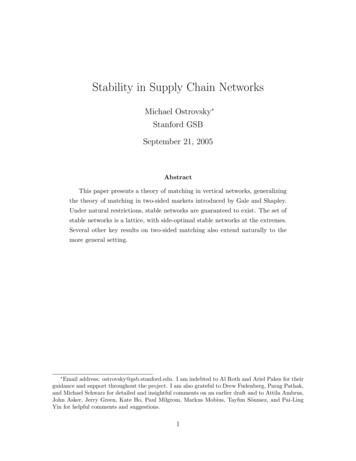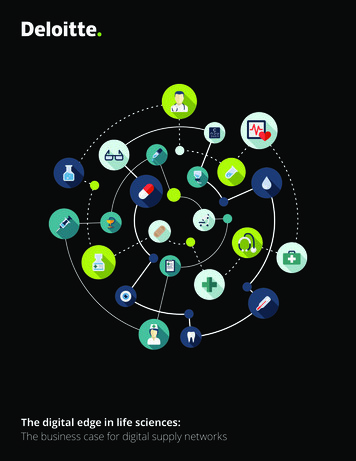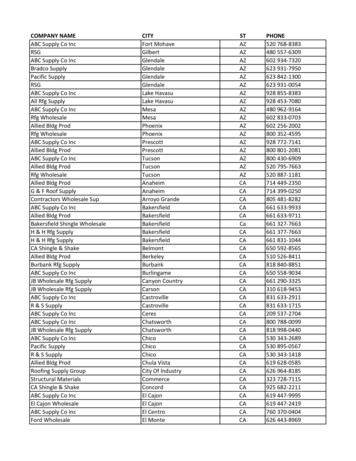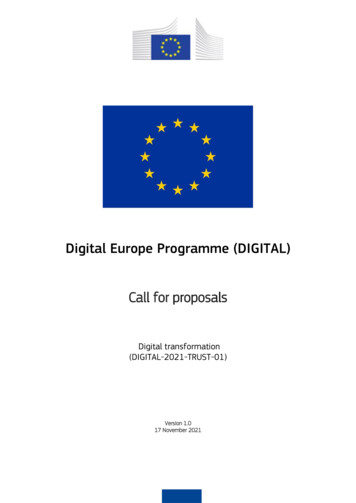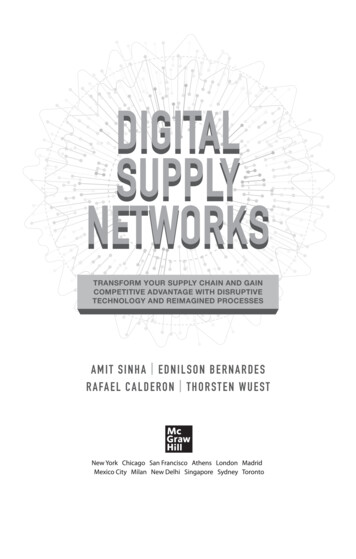
Transcription
DIGITALSUPPLYNETWORKSTRANSFORM YOUR SUPPLY CHAIN AND GAINCOMPETITIVE ADVANTAGE WITH DISRUPTIVETECHNOLOGY AND REIMAGINED PROCESSESA MI T SI NH A E D NI L SON BERNARDESRA FAE L CAL D E R O N T HORS TEN WUES T9781260458190 SINHA PASS3.indd pg 1 Pass 3 5/18/20THINK Book Works5/18/20 4:19 PM
314Digital Transformation and Its Impact onSupply Chain ManagementDigital Supply NetworkBig Data and Data AnalyticsMachine Learning, AI, and RoboticsEnd-to-End Transparency and TrustThrough BlockchainSynchronized PlanningDigital Product DevelopmentIntelligent SupplySmart Manufacturing and Intelligent Asset ManagementDynamic FulfillmentConnected CustomerWorkforce, Skill Changes, and Social ImpactDSN Transformation PlaybookUse 87Indexiii9781260458190 SINHA PASS3.indd pg 3 Pass 3 5/18/20THINK Book Works5/18/20 4:19 PM
9781260458190 SINHA PASS3.indd pg 4 Pass 3 5/18/20THINK Book Works5/18/20 4:19 PM
FOREWORDWith more than two decades of professional experience leading supply chain transformations, I have witnessed the transformation of thesupply chain itself from a business support function to the center ofan organization’s strategy. For the prosperity achieved in the past 25years, along with the higher standard of living across the globe, supply chain management (SCM) has played a crucial role by optimizingefficiency, enhancing productivity, and reducing waste. It would notbe an overstatement to say that the supply chain has shaped the worldwe live in.The technological progress that happened over the past threedecades allowed organizations to create a connected supply chain ofbusiness activities, enabling end-to-end planning and execution ofprocesses and workflows. However, through recent technological andprocess advancements, the basic idea of supply chain management isoutdated. Adoption of advanced technologies consisting of sensors,machine learning, artificial intelligence, blockchain, and robotics havefacilitated end-to-end visibility, control, and automated decision making. In this new way of working, a traditional chain will be replaced bythe always-on, always-connected, transparent, dynamic networks. Wecan call this a “digital supply network,” or DSN.As the global co-founder of Digital Supply Networks, at Deloitte, Ihave helped many organizations achieve tremendous value through theadoption of DSN-enabling processes. This book is intended to providecomprehensive knowledge about the DSN processes and associatedtechnologies as well as an adoption playbook. I got the opportunity toshare my thoughts and help the author team by reviewing the contentv9781260458190 SINHA PASS3.indd pg 5 Pass 3 5/18/20THINK Book Works5/18/20 4:19 PM
Forewordand providing feedback. I am delighted by the content quality andcoverage of this book. I must congratulate the author team—AmitSinha, Ednilson Bernardes, Rafael Calderon, and Thorsten Wuest—for putting together this comprehensive text on DSN.At present, we certainly find ourselves in an intricately complicated time, one that has been disrupted in the blink of an eye by anunforeseen virus. As of this writing, COVID-19 has brought societiesto a halt, placing many leading economies into self-imposed “comas”to stunt the spread of the coronavirus and avoid overwhelming healthcare systems. Economies are currently going through the painful taskof re-opening, balancing the potential for more fatalities with the needto restart activities to avoid further economic catastrophe. And let usnot forget the tremendous toll this virus is having on the human workforce that participates in the many industries that feed the economy.The current pandemic has shed a glaring light on the vulnerabilities of traditional supply chains across industries—from healthcareto retail, industrial manufacturing to pharmaceutical. Raw materials and components stopped shipping. Supplies were unable to reachtheir destinations due to canceled air flights and trucking capacity.What started in a few distinct geographies quickly blossomed into adomino-effect of supply disruptions, grinding production to a haltacross regions and sectors. If there ever was a watchword for the current environment, it would be resilience.Resilience can mean many things, but at its core, it defines theability of an organization or organism, to recover from a shock to thesystem, rapidly adapting and adjusting to the new circumstances.Many companies have been on the road toward building resilience intheir supply chains for several years, preceding this current massiveshock. They have added digital technologies like forecasting and evenartificial intelligence to help connect activities across the chain, bringing demand and supply more closely in sync through technologies andprocesses that enable greater visibility and planning. However, despitethese efforts, the vast majority of supply chains are still falling far shortof the end state of resilience, in many ways.Now, more than ever, it is apparent that building resilience into thesupply chain is a business imperative—along with the need to replacethe “chain” and its linear approach with a “network” that reflects thefluid nature of the business that all companies experience. Those companies that fail to do so will likely not survive this current crisis.The current wave of digital transformation is changing the business rules across the world. I believe that the most crucial part of digitalvi9781260458190 SINHA PASS3.indd pg 6 Pass 3 5/18/20THINK Book Works5/18/20 4:19 PM
Forewordtransformation or any business transformation is the consumer and thesolutions businesses provide to its customers. In addition, I visualizeDSN playing a vital role in providing safety, quality, value, and innovation to all stakeholders. The intelligence possibilities for machinesthrough artificial intelligence allows business teams to run an intelligently automated enterprise through total visibility and fact-baseddecision making. The dynamic decision making in this intricately connected world needs to consider multiple factors to achieve the requiredadaptability, responsiveness, and resilience.With the industry and institution collaboration achieved for thisbook, it is relevant to executives, managers, consultants, students, andacademics. The progress from SCM to DSN is well articulated alongwith the traditional SCM processes and reimagined DSN processes.I recommend this book for executives who want to understand thebasic concepts of advance technologies like data analytics, machinelearning, artificial intelligence, robotics, and blockchain. The textelucidates the basics of these technologies, managerial applications,and how to harness the power of those technologies. The real-worldexamples shared throughout the chapters that define the digital supply network, introduce the technologies that power it, and describe itsmeasurable business impact are inspirational for companies of all sizesand types. I was able to share my ideas for the DSN playbook, whichhas been captured well through further research and the expertise ofthe author team.We are seeing positive examples of digital supply networks in operation today that are helping companies respond to the current crisisand demonstrate the agility that is critical for survival. I am hopefulthat the current crisis we are experiencing will serve as the wake-upcall for business leaders to lift the covers off their supply chains andbuild a sustainable strategy for creating a digital supply network thatwill engender the resilience every company needs to not only survivebut thrive.I invite you to a tremendous learning journey on digital transformation and digital supply networks through the wisdom shared inthis book!Adam MussomeliPrincipal, Supply Chain & Network Operations LeaderDeloitte Consulting LLPvii9781260458190 SINHA PASS3.indd pg 7 Pass 3 5/18/20THINK Book Works5/18/20 4:19 PM
coverage of this book. I must congratulate the author team—Amit Sinha, Ednilson Bernardes, Rafael Calderon, and Thorsten Wuest— for putting together this comprehensive text on DSN. At present, we certainly find ourselves in an intricately compli-cated time, one that has been disrupted in the

